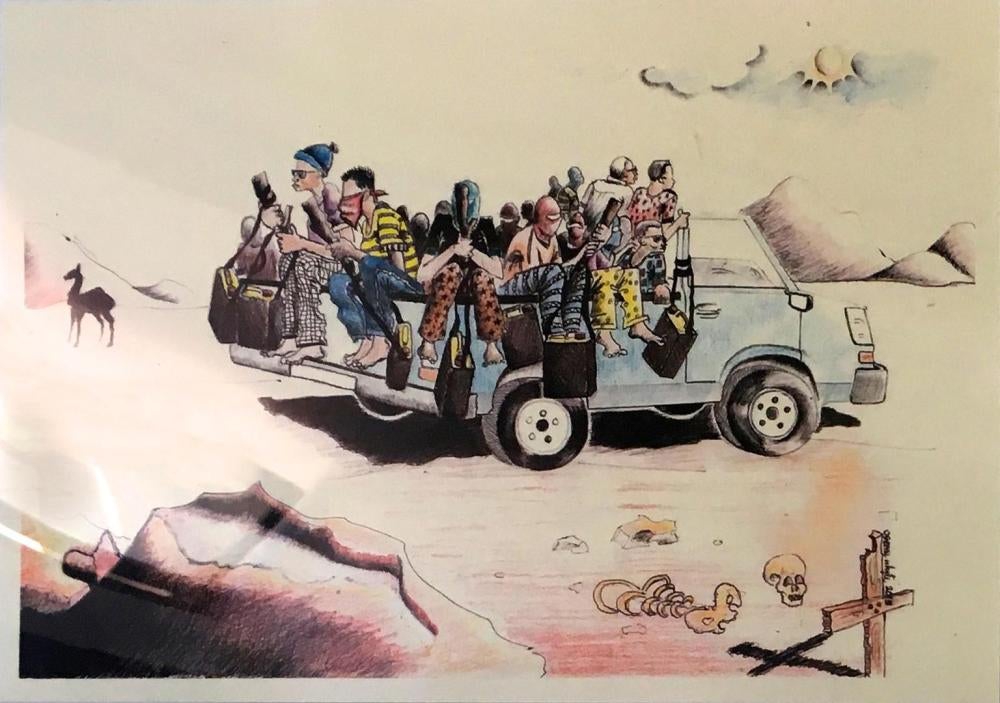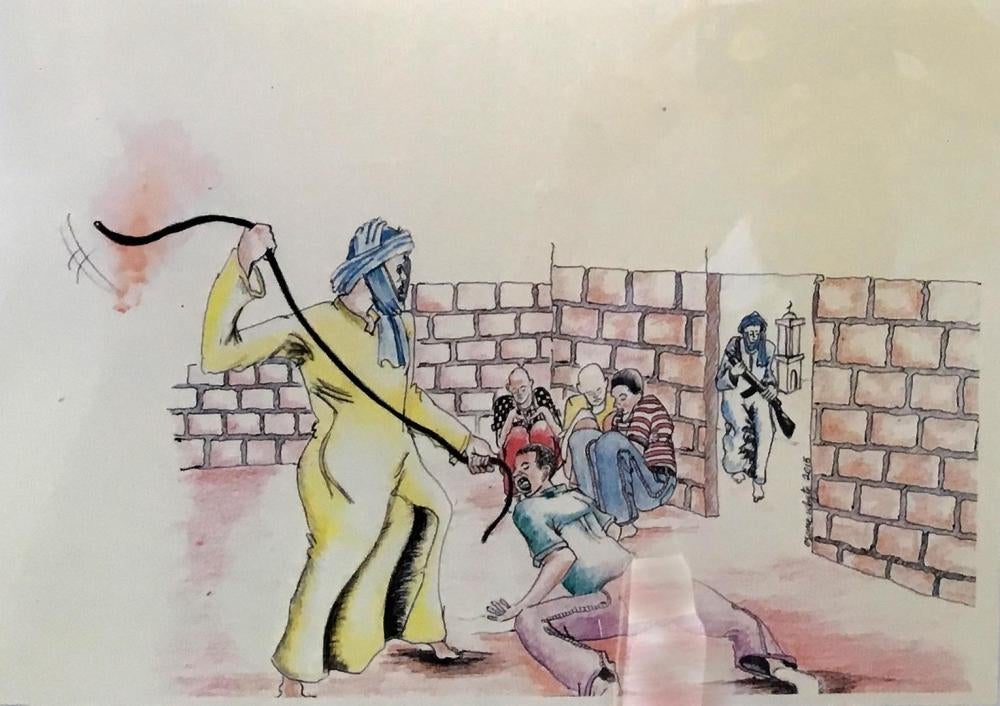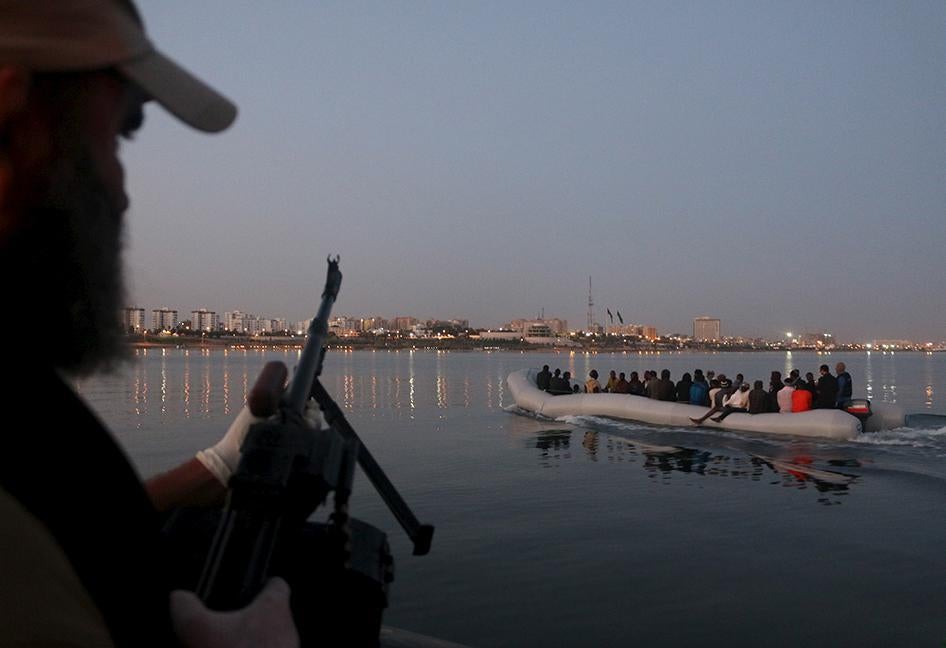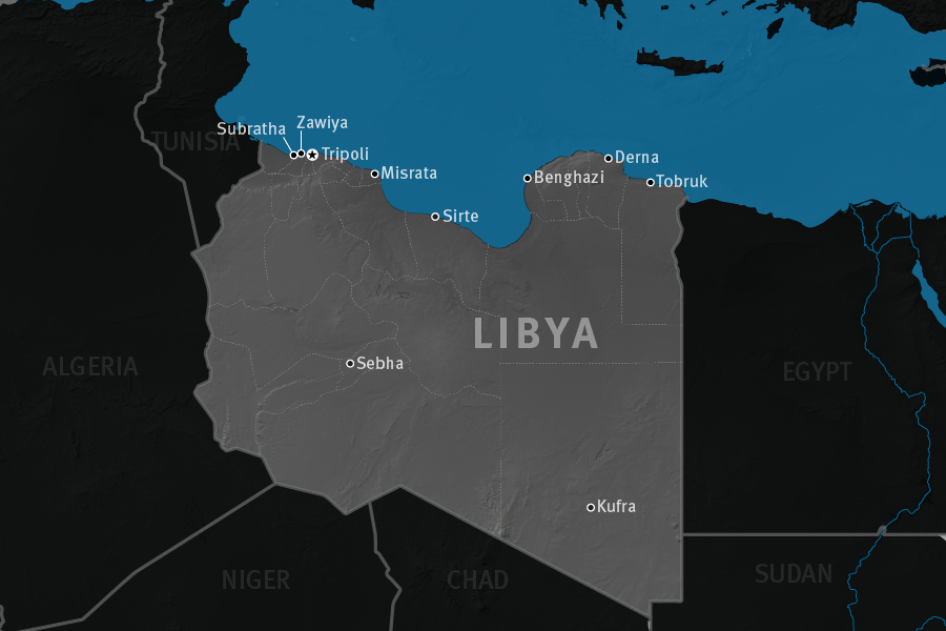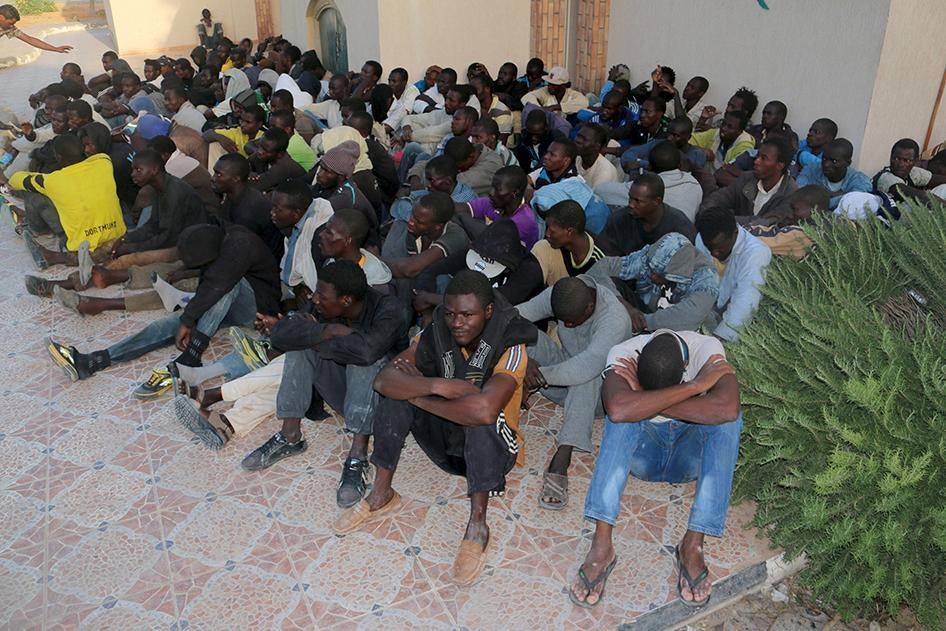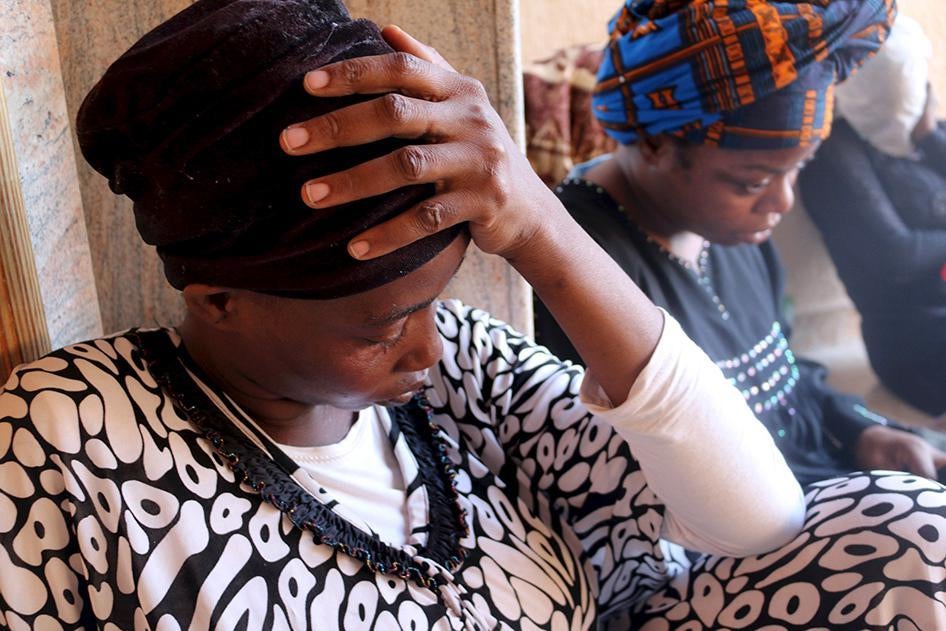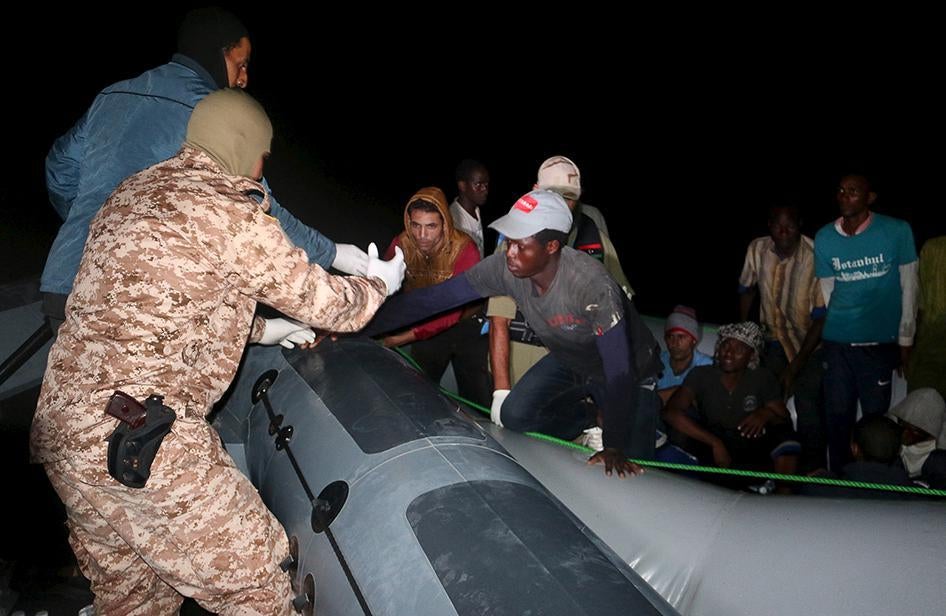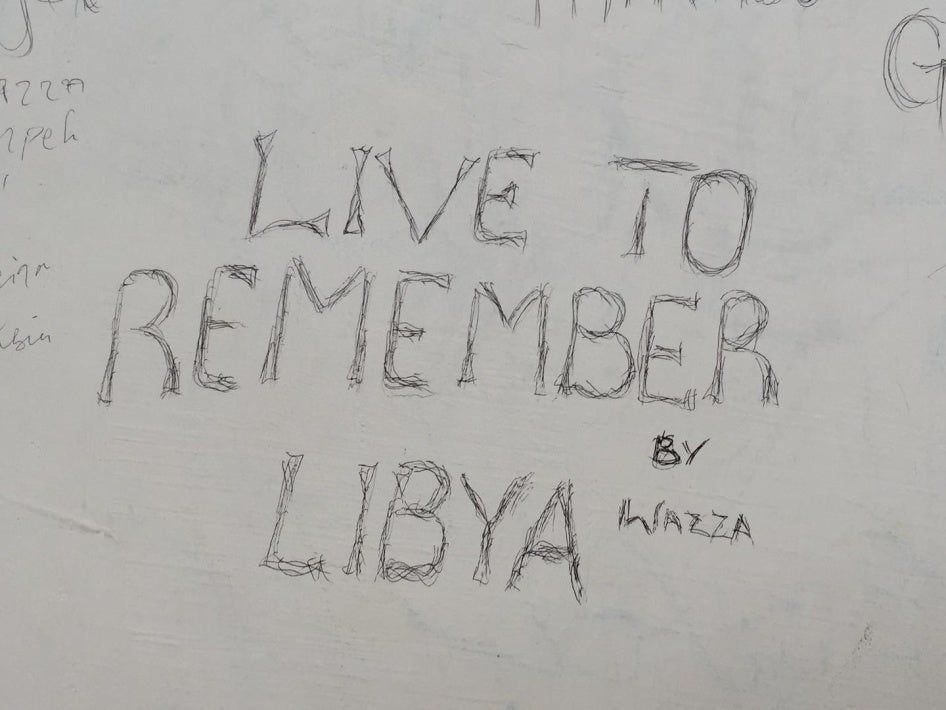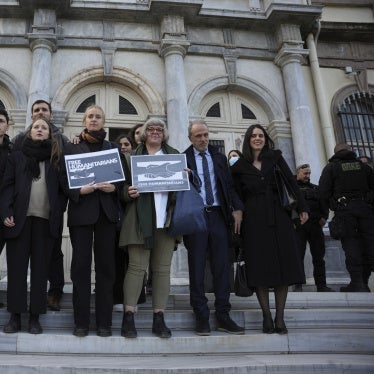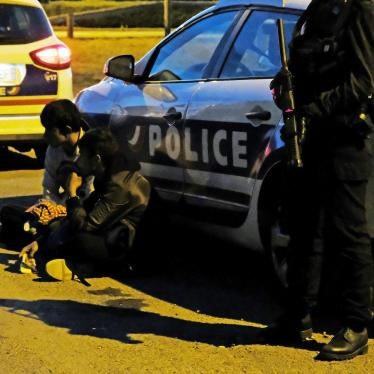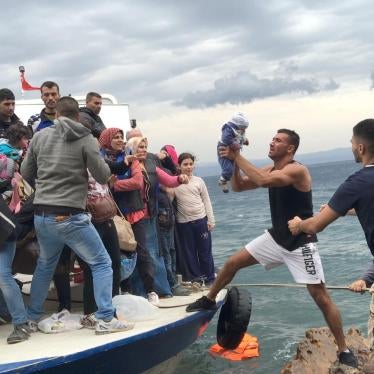(Brussels) – European Union efforts to stem migration from Libya risk condemning migrants and asylum seekers to violent abuse at the hands of government officials, militias, and criminal groups in Libya, Human Rights Watch said today. Newly documented abuses include torture, rape, and killings in squalid detention centers where migrants, including people intercepted at sea by the Libyan Coast Guards, are detained.
On June 20, 2016, the EU extended its anti-smuggling naval operation in the central Mediterranean to include training the Libyan Coast Guards and Navy, which are intercepting boats and sending migrants and asylum seekers back to Libya. The EU is also asking NATO to assist its operation. NATO members will discuss options at their summit in Warsaw on July 8 and 9.
“The EU isn’t sending people back to Libya, knowing that’s unlawful, so it wants to outsource the dirty work to Libyan forces,” said Judith Sunderland, associate Europe and Central Asia director at Human Rights Watch. “The EU – soon perhaps with NATO’s help – is basically deputizing Libyan forces to help seal Europe’s border.”
At present, EU and NATO vessels are not allowed to operate in Libyan territorial waters. The EU has acknowledged that, under international law, it may not send people rescued in international waters back to Libya due to extreme dangers in that country.
In June, Human Rights Watch interviewed 47 people in Sicily, 23 women and 24 men, who had recently travelled from Libya to Italy on smugglers’ boats. Those interviewed – from Cameroon, Eritrea, Gambia, Guinea, Ivory Coast, Nigeria, Senegal, and Sudan – said they had left their homes to flee persecution, including abusive military service, to escape forced marriage, or to seek education and work. They described severe abuses in Libya by government officials, smugglers, and members of militias and criminal gangs, and at times collaboration between officials and smugglers. Rampant lawlessness and violence across Libya convinced those who had gone there for work to attempt the perilous sea crossing to Europe.
“In Libya, they do whatever they like because there’s no law, no nothing,” said a 31-year-old Gambian man, who told Human Rights Watch that criminals had raped his wife.
Eight of those interviewed said Libyan forces they believed to be from the Coast Guards or Navy had intercepted their boat in various incidents and taken them and other passengers back to land, sometimes beating them. On shore, they were held in immigration detention centers with others apprehended on land for entering Libya irregularly or not having permission to stay.
Most of the centers are run by the Department for Combating Illegal Migration (DCIM), under the Interior Ministry, which is nominally controlled by the UN-backed and EU-recognized Government of National Accord, one of three competing authorities in Libya. According to an international task force that visits the facilities, DCIM runs approximately 20 centers, most in western Libya, holding roughly 3,500 people. Militias and smugglers run many other non-official detention facilities.
Conditions at DCIM centers in Tripoli, Zawiya, and Subratha were abysmal, former detainees said. They reported extreme overcrowding, filthy rooms, and insufficient food. Abuses included killing, beatings, forced labor, and sexual violence against men and women.
It was inhumane there. I have many scars…. Six men hanged themselves in my room. [They were] men who had been sodomized, who couldn’t take it anymore. It [rape] happened to me seven times. Four or five men at once, beating me to hold me down. If you resist, they call others to beat you more.
In addition to physical abuse, all of the former detainees said no one took them before a judge or allowed them to challenge their detention. Prolonged detention without judicial review amounts to arbitrary detention and is prohibited under international law.
Four people described abuses and dangerous maneuvers at sea by the Coast Guards. In one case, the forces sped around a migrants’ rubber dinghy, causing panic. A Nigerian woman was crushed to death.
Given the chaos and violence in Libya, in October 2015 UNHCR, the United Nations refugee agency, called on all countries to “allow civilians (Libyan nationals, habitual residents of Libya and third country nationals) fleeing Libya access to their territories.”
EU policies that result in preventing migrants and asylum seekers from leaving Libya, or that return them to Libya to face serious abuses, contradict the spirit of UNHCR’s call and violate international law, Human Rights Watch said. Article 12(2) of the International Covenant on Civil and Political Rights grants people the right to leave any country, including their own.
The EU should ensure that none of its training, financing, or material assistance to the Libyan Coast Guards and other Libyan authorities worsens human rights abuses, Human Rights Watch said. The EU should support monitoring and public reporting by international observers, including the UN and EU agencies, about detention facilities in Libya, including centers where those rescued or intercepted by the Libyan Coast Guards are detained. The EU should also press Libyan authorities to end abuse in detention, offer alternatives to immigration detention, and ratify the 1951 Refugee Convention.
To assist Libyans and non-Libyans alike, the EU and its member states should generously fund the humanitarian response in Libya, Human Rights Watch said. As of April 2016, the UN’s humanitarian appeal had received only 18.2 percent of the required US $165.6 million.
Any NATO support for EU naval operations should avoid contributing to trapping migrants and asylum seekers in Libya. All NATO vessels in the central Mediterranean should have the mandate and capacity to conduct search and rescue.
The UN-backed government in Libya should work to end torture and other ill-treatment in all detention facilities under its control. It should detain people for immigration purposes only when strictly necessary and for the shortest possible time.
“Supporting Libyan forces should be accompanied by ending torture and abuse in the facilities where those forces are sending people,” Sunderland said. “It’s unacceptable to save or intercept people at sea and then send them back for abuse on land.”
Abuse in Official Detention Centers
Migrants detained in facilities run by the Department for Combating Illegal Migration (DCIM) told Human Rights Watch about a wide range of abuses, including killings and sexual assault.
A relatively autonomous body under the Interior Ministry, DCIM runs approximately 20 detention centers, most in western Libya, holding people who were detained on land during house raids or identity checks or intercepted at sea. The UN-backed government has ostensible control over the ministry, but its influence is weak. Across the country, militias, smugglers, and gangs run an unknown number of unofficial detention facilities for foreigners.
A Detention Task Force co-chaired by UNHCR and the International Organization for Migration with members from the Danish Refugee Council, International Medical Corps, Consiglio Italiano Per Rifugiati and others has access to DCIM centers. It provides health and hygiene kits, identifies people for voluntary return to their home countries, assists those who wish to register as refugees, and advocates for the release of vulnerable detainees.
According to the task force, DCIM centers currently hold roughly 3,500 people, the vast majority men. Two centers, in Surman and al-Gawa in Tripoli, hold between 100 and 200 women between them, but other centers also hold women. The UN, nongovernmental groups and DCIM officials themselves say that DCIM is overstretched and underfunded.
The UN mission in Libya, UNSMIL, visited DCIM facilities until its evacuation from Libya to Tunisia in July 2014. Since then, it has visited one facility, Tripoli’s Abu Salim detention center in May 2016, and continues to monitor detentions, including in DCIM facilities, while based in Tunis.
UN agencies have repeatedly highlighted dangerous and inhumane conditions in the centers. “Detention conditions are inadequate, often characterized by chronic overcrowding, poor sanitation and health care, and insufficient food,” UNHCR said in a February 2016 report. “Violence is endemic.”
On April 1 at the al-Nasr detention facility in Zawiya, guards shot dead four detainees and wounded approximately 20 others after an apparent escape attempt, UNSMIL reported. A guard was also injured. “It is reported that conditions in the detention centre are inhumane, with severe overcrowding, shortages of food and other basic necessities, and no access to medical care,” the UN said.
A June 2016 Amnesty International report documented torture and other ill-treatment at immigration detention centers. Former detainees said guards “beat them on a daily basis using wooden sticks, hoses, electric cables and rifles as well as subjecting them to electric shocks.”
Under Libyan law, individuals may be indefinitely detained and deported for irregular entry, stay, or departure, with no distinction between asylum seekers and refugees, migrants and victims of trafficking.
Under international law, Libyan authorities may detain people only for immigration purposes when strictly necessary and for the shortest possible time. Every detainee should be taken promptly before a judge who can rule on the legality and necessity of detention and order a release.
Sexual Violence
Human Rights Watch spoke with three people who said they had experienced sexual violence in immigration detention centers.
“Nourah,” a 26-year-old Ivorian, said she was detained in June and July 2015 at a facility in Tajoura, on the eastern edge of Tripoli, because she did not have residence papers. A guard called Ibrahim repeatedly abused her sexually, she said:
He didn’t have a thumb or index finger on his left hand, I remember very well. He would come to the room and roll his cigarette and smoke among us. It was a strange smell. He chose me. He took me, he had the condom in his hand. He made me give him oral sex. He came every night. Only Fridays he didn’t come.
Nourah said other guards took women away and abused them sexually. “There was a man who covered his face, he was the meanest,” she said. “He would come into our room, with three or four other men. They would come to choose the girls. One girl, an Eritrean named Amira, they chose her every time. Every time they came for her she would cry.”
“One day we tried to escape, going through a hole in the wall,” Nourah said. “Seven girls got away but they caught the rest of us. The guards stripped one of us, a Nigerian girl, and raped her in front of us in the courtyard.”
Several men said they witnessed or heard about sexual abuse in the detention centers where they were held. “Jabril,” 30, from Gambia, who spent six months in 2015 at a facility in Subratha after his boat was intercepted, said he saw guards frequently take women away. “At night they take women to use them,” he said. “They go and say, ‘One, two, three – come here.’”
“Sondi,” a 30-year-old Nigerian man, said he spent one month detained in Tripoli, locked in a cell with an iron door that had a tiny window. The women were kept separately but he managed to speak with one of them when he went to get water for the cell’s only toilet. “They [the guards] would take the Nigerian girls and sleep with them,” he said. “I spoke to one when I went to get water, and the girl told me it had happened to her and other girls.”
A psychologist working at the Mineo asylum reception center in Sicily said she and her colleagues have noticed an “exponential increase” in reports of sexual violence over the last six months. “I know because we’ve seen an increase in requests for support,” she said. “Sometimes the catalyst for the request for support is a shipwreck, but then people talk a lot about sexual violence. It’s impossible nowadays to get through Libya without being jailed, abused.”
A doctor who has worked for one year at the Pozzallo migrant registration center in Sicily said that women who travel through Libya frequently report sexual violence and request medical care, including abortions. On every disembarkation of people who were rescued there is at least one case of rape, and sometimes up to four, the doctor said.
“Mehret,” a 16-year-old Eritrean, said she had been raped by criminals near the Shagarab refugee camp in Sudan before entering Libya. She had been staying at Pozzallo for two weeks, but had not spoken with a doctor or anyone else about the attack. “If they don’t ask me, what am I going to say?” she said.
The availability of staff psychologists and mental health services in centers for new arrivals and longer-term reception varies. To fill the gaps, nongovernmental organizations, including Doctors for Human Rights (Medici per i diritti umani), Doctors Without Borders, and Terres des Hommes, run projects in first-arrival and reception centers for victims of sexual violence, torture, and survivors of shipwrecks. But the large number of people arriving, limited capacity, and overwhelming needs prevent many people from getting needed care. Most of the women and men Human Rights Watch interviewed said that no one had asked them specifically about sexual violence they had experienced during their journeys.
Killings, Beatings
Migrants and asylum seekers in Sicily described extreme violence in Libyan immigration detention centers, including beatings and deadly shootings.
“Medhane,” a 21-year-old Eritrean, said he was detained twice during his 18 months in Libya. He was first apprehended in a July 2015 raid and held for about four months in the DCIM-run Salaheddin facility in Tripoli because he had no residence papers. He stayed in a large hall with about 500 people, sleeping on the floor, with occasional visits from doctors. “Their excuse for beating us was that we didn’t have the papers,” he said. “They used hoses to hit us everywhere whenever they wanted.”
Medhane said he was released in October 2015 because the guards realized he couldn’t pay the money they were demanding. In April 2016 he tried taking a smuggler’s boat to Italy with about 100 other people but they were stopped by what he called “Libyan sailors.” The group was taken to a detention facility near the coast in Tripoli:
It was terrible, really awful. The guards were scaring us with their guns…. There were around 300 people already there, and more came after us. We stayed in the cells. I don’t know how many of us were in there, but we couldn’t lie down to sleep. Just had to sleep sitting…. They beat us, always looking for money, always searching our clothes.
Medhane said he spent 21 days at the facility until he and others in his cell managed to escape through a window one night. He arrived in Italy in May 2016.
Jabril from Gambia said that in 2015 Libyan forces twice intercepted boats he was on, and sent him back to Libya, where he was detained and abused. He spent six months detained in Subratha, and then another six months in Tripoli. In both places, Jabril said the guards routinely beat him and the other detainees: “If you are talking, they ask, ‘What are you saying? What are you saying? Stop.’ Then they beat you. Or they beat you when you’re sleeping.”
“Demsas,” a 24-year-old from Eritrea, said that in September 2015 Libyan authorities intercepted the boat that he and his wife were on after about an hour-and-a-half at sea and took them to a detention facility on the outskirts of Tripoli. “It was horrifying because the walls were full of people’s blood, the smell was very bad,” he said. “Many people had allergies, skin problems.”
One day in November, the guards ordered Demsas and four other men to clean outside the prison. One of the men, a Nigerian, tried to escape but was caught, Demsas said:
A guard came [later] and asked who had tried to escape. He discovered who it was. They shot him twice. His blood spurted onto my shirt. At that moment I thought they had killed me. They wrapped him in a white cloth and put him in a car and took him away.
At one point, a foreign visitor came, Demsas said. Before he arrived, guards and officials took the detainees to a separate, cleaner facility and warned them that they would kill anyone who complained. “They asked us how many times a day we were eating,” Demsas recalled. “We had been told to say three times a day; we said three times a day.”
Demsas said people could buy their way out of the facility. “The smugglers gave 500 dinars [US $360] to the prison director per prisoner,” he said. “Then the prisoners paid $2,000 to the smugglers [to go to Europe].”
Former detainees, and others who were not detained, described an apparent cooperation between smugglers and Libyan detention officials, including cases of detainees performing forced labor and paying to be released. “I saw the relations between smugglers and police,” said a 44-year-old Eritrean man who spoke Arabic and spent five months working in Tripoli. “The head of a prison sells Eritreans to smugglers. It’s big business.”
“We had to pay police along the way, in the desert and even on the coast, before they let us go,” said “Makda,” a 38-year-old Eritrean mother of four who paid smugglers to take her and her youngest child, a four-year-old boy, from Sudan to Italy.
“Aisha,” a 27-year-old Gambian, said criminals captured and raped her and another woman in March 2016 before handing them over to what she called “police.” She was then detained in an immigration facility in Zawiya, where she said she was also raped, and then transferred to the DCIM-run facility for women in Surman.
Others spoke of being forced to work outside the detention facility. “When they choose you, it’s just the guards pointing and saying you, you, you,” said “Aman,” a 22-year-old Eritrean who spent three months in detention in Zawiya after Libyan forces intercepted the boat he was taking to Italy. “But then if you work well, the employer will ask for you.”
“The commander [of the detention facility] would come once in a while, saying we were there because we were illegal,” Aman recalled. “He said they were working on a deal with the smugglers to take us to Italy.”
“Aniyan,” a 22-year-old Nigerian, said he was detained with four other migrants who were working with him in a car wash in Tripoli and spent August to December 2015 in a Tripoli detention facility. “In four months, I saw three people die [from illness], one Ghanaian, one Senegalese and another guy,” he said. “We were beaten a lot… I still have pain on my back [from the beatings].”
“Foday,” a 27-year-old Gambian, said he spent from December 2015 to May 2016 in Tripoli’s Salaheddin detention center, run by DCIM, with about 600 other men. He was held in a large room with no windows, sleeping on the ground without a mattress, blanket or sheets. “They would make us put our hands under our legs and then beat our feet with sticks or whatever they had,” he said. “Sometimes they took belts and whipped me…. We’d go outside only for work, or for beatings. They beat us in the hall, but sometimes they took us out. They would spray us with water and then beat us. All the time they were shooting. They shot at people trying to escape.”
Jabril, the 30-year-old Gambian, said he saw the guards at Subratha break up a scuffle between detainees by opening fire and killing a man. “One day I saw them come to the prison [to] give bread, give food,” he said. “Everyone ran to come and get the bread. Then they shot at the men. One man was dead, two were wounded. Why shooting? At nothing. They took the dead man. I don’t know where. The other men they took to the hospital and brought them back.”
Abuses by the Coast Guards
Human Rights Watch heard four accounts of abuse, including beatings, by the Libyan Coast Guard during interceptions at sea.
“Abdoulaye,” a 21-year-old Guinean, said that in May 2016 six men in camouflage military uniforms in a large Zodiac inflatable speedboat intercepted the boat he was in, beat people on the boat, and took them to an immigration detention facility in Zawiya. Two of the men boarded his boat, and one drove them back while the other hit people with a baton. “They put us all in the middle of the boat, and he hit us with a baton and a Kalashnikov, anyone he could reach,” Abdoulaye said.
“Ibrahim” 20-year-old Ivorian, said he took a rubber dinghy with 132 people from Sabratha on March 19, 2016, but was intercepted by what he thought were official Libyan forces:
We left around 3 or 4 in the morning but we got lost. A Libyan Zodiac, black with the Libyan flag, caught us. Six or seven men were onboard. They came up beside us and threw a rope to attach our boat to theirs, but we refused. They said ok, go, and we cheered but we realized later they had taken our walkie-talkie [phone]. Then the Libyans started circling around and around our boat, really fast, making big waves. The planks at the bottom of our boat started to break, one by one. There was panic onboard. People were moving from one side to the other. There was a girl in the middle, with her sister, and near me. Nigerian. She was trampled, she died. We thought she had just fainted.
Ibrahim said the Libyans sped off, and the group was eventually rescued by a European boat.
“Our boat was falling apart,” he said. “I was one of the last ones off. I saw the girl, she was maybe 16 or 17. Her skin was practically flayed. I still have nightmares. I see myself on that boat.”
“Issouf,” a 20-year-old Ivorian, said two officers in military uniform on a fast Zodiac intercepted his rubber dinghy on a Sunday in late May, and one of the officers boarded Issouf’s boat:
We asked to keep going. They [the officers] demanded a phone number to call the trafficker but we didn’t give it to them. I had the phone, but our driver made a sign to not give it to the officer. I dialed anyway but there was no answer. The other officer said to let us go, but the one on our boat said no. He was wearing a beige camouflage uniform. He drove us back to Libya.
When we were close to the shore, he pushed people into the water. There were 125 people on our boat, and only 105 made it. I think 20 people died. I hung onto the boat, and ended up in the water when it was only knee-high. It was around 11 in the morning, near Sabratha but not a real port.
According to news accounts, the Libyan Coast Guard reported intercepting seven boats on May 22, but Human Rights Watch was not able to verify Issouf’s allegation that the officer intentionally pushed people overboard.
“Aman,” the 22-year-old Eritrean, said Libyan forces blocked his boat on two occasions but he made it on the third try, arriving in Italy in March 2016. On the first try, in late October or early November 2015, two Libyan sailors on a fast Zodiac, one wearing a blue uniform and the other with an off-white uniform, came after about two hours at sea. The word “police” was written on the boat in English, he said.
“One of them came over to our boat, started looking for the driver,” Aman said. “He treated the Moroccans on board really badly, hitting them, because he wanted to find out who was driving… Then the Libyan started driving us back to Libya, saying he had saved us because we never would have made it to Italy. But then we ended up in prison.”
The group was taken to a port in Zawiya, where they were searched, Aman said. One Eritrean had a compass so they thought he was the driver and they threw him in the water. Another Libyan threw him a rope and pulled him out. At one point, they shot at a Moroccan, apparently to scare him, but they hit him in the foot, Aman said.
Abuse by Smugglers, Militias, Gangs
The migrants interviewed reported a litany of abuses at the hands of smugglers, and members of militias and gangs. Abuses included rapes, beatings and killings, with no intervention or protection provided by Libya’s weak law enforcement agencies. In some cases, gang and militia members forced people to work until they could earn enough money to pay for the next stage of their journey. In other cases, the captors detained them in makeshift prisons until relatives back home sent money.
The violence and exploitation often began when migrants crossed Libya’s southern border, from Sudan, Niger, or Chad, interviewees said. Driven through the desert on smugglers’ trucks, the migrants were frequently beaten or tortured and forced to work.
Five women interviewed said smugglers or criminals had raped them in Libya. A sixth said that smugglers had sexually abused her there and that she saw men take other girls away. Three Eritreans, including a 16-year-old girl, said smugglers had raped them in Sudan, and a fourth said smugglers had sexually abused her there. Another Eritrean woman said criminals had raped her in Chad.
“Aisha,” the 27-year-old Gambian, said she spent about 11 months in Libya cleaning houses, beginning in mid-2015. In March 2016, an armed gang in Tripoli robbed the group of Gambians she was with and tried to separate her and another woman from the group. Her cousin intervened and they shot him dead, she said.
Members of the gang raped both Aisha and the other woman. “They raped us, two men each. You understand?” she said. “I was shouting. They made me bleed.”
The gang members then took the two women to what Aisha said was a police station and handed them over to the police. She stayed there for five hours and was then taken to a prison in Zawiya, where she stayed one week, she said. During that time, she said guards raped her three times.
“Arsema,” a 22-year-old with Eritrean and Ethiopian parents, said a smuggler had raped her in southern Libya. “One smuggler, he took us to his house – me and a girl – she was 18,” she said. “First he abused me – rape. Then he asked me to clean his house. But I was crying and I couldn’t. Another man, the guard of his house there, he abused the 18-year-old sexually.”
An 18-year-old woman from Eritrea, “Tsibekti,” who also said a smuggler raped her, said that women traveling through Libya were paying 80 dinars in Khartoum, Sudan, for an injection they were told would prevent pregnancy because they knew the risks in Libya. She and three other women who said they were also injected in Sudan did not know the type of medication.
Another woman from Eritrea, 38-year-old “Makda,” told Human Rights Watch that smugglers had sexually abused her in Sudan and Libya. She also saw unidentified men take other women away in Libya. “I saw how they came to the place where we were waiting for the boats and they took the girls,” she said. “I can’t say if they were police or smugglers but they were the people in charge of protecting us.”
Makda said two men took two women. “The women were gone for about 30 minutes,” she recalled. “[When they came back] you couldn’t even talk with them or you would get beaten but we’re women and we could see what happened to them – they were crying.” Makda thought she was not raped in Libya because she was traveling with her four-year-old son.
Men interviewed by Human Rights Watch also reported abuse, including forced labor on farms and construction sites, by smugglers and other private actors.
“Michel” from Cameroon said he spent two years in detention in Kufra from 2014 to 2015 at the hands of an unknown group who demanded 5,000 dinars ($3,600) for his release. Because he and others could not pay, they were forced to work on a farm, he said.
“Kufra was hard, lots of people died,” Michel said. “They did so many things to me, I can’t talk about it. It’s like a horror film.”
Michel showed Human Rights Watch two scars on his arms where he said guards in Kufra had burned him with a scalding hot knife.
”Omar,” 18, from Senegal, said an armed group captured him in Subratha in January 2015 and held him for one year, forcing him to work. “They said they were the police,” he said. “They had different clothes but all of them had guns. Even the bandits there say they are police.”
Chaos in Libya
Abuses against foreigners in Libya take place within a context of conflict and disorder after the fall of Muammar Gaddafi in 2011, as well as widespread racism in Libya. In 2014, Human Rights Watch reported on torture and inhumane treatment in official immigration detention facilities, and the situation does not appear to have improved.
Libyans are also suffering greatly from the collapse of law and order and armed conflicts in parts of the country. The UN estimates that 2.44 million people in Libya are in need of protection and some form of humanitarian assistance. According to IOM, as of June 2016, roughly 425,000 people were internally displaced. A December 2015 report by Human Rights Watch documented long-term arbitrary detention, torture and other ill-treatment in four non-immigration prisons in Tripoli and Misrata.
The three authorities vying for control in Libya include a “unity” government backed by the United Nations and European Union. The Libyan Government of National Accord has established a presence in Tripoli but has not managed to exert its authority over the many powerful militias that hold sway over large parts of the country. The “unity” government and other forces are also engaged in armed conflict with the Islamic State, which for months has controlled the central coastal city of Sirte, committing serious violations against residents there.
According to IOM, in the first six months of 2016, 67,538 people reached Italy from North Africa, most from Libya, and 2,920 people drowned or went missing in the Mediterranean Sea (compared with 1,838 dead or missing in the first half of 2015). At least 264,000 migrants, asylum seekers, and refugees are in Libya, most from sub-Saharan Africa. According to UNHCR, as of May, the UN agency had registered 9,300 refugees and 28,268 asylum seekers in Libya, 18,986 of them Syrian nationals. Libya does not have an asylum law and has not ratified the 1951 Refugee Convention.
The Italian Navy and Coast Guards, the EU’s Frontex mission Triton, the EU’s naval operation EUNAVFOR MED Operation Sophia, as well as numerous nongovernmental organizations, operate in international waters off the Libyan coast and conduct rescue operations. EU-flagged ships are bound by the principle of non-refoulement, which bars returning anyone to a place where they face threats to their lives and freedoms.
At its summit on July 8 and 9 in Warsaw, NATO is planning to discuss cooperation with the EU naval operation in the central Mediterranean. NATO Secretary General Jen Stoltenberg said on July 4 that NATO might provide ships, aircraft, intelligence, or other capabilities.
Recommendations
Given the extent of the problem and the lack of a functioning Libyan government, the crisis for migrants, asylum seekers and refugees in Libya has no simple solution. A multi-pronged effort is required by Libyan authorities and international actors, especially the EU and its member states, that prioritizes respect for rights over closure of borders and feeds into the larger goal of stabilizing Libya and building rights-respecting institutions.
To the EU and member states:
- Ensure that no training, financing or material assistance to the Libyan Coast Guards and other Libyan authorities worsens human rights abuses in Libya.
- Prioritize search and rescue operations over interception when training the Libyan Coast Guards and Navy.
- Fund and implement programs to improve conditions at immigration detention centers.
- Support monitoring and public reporting by international observers, including the UN, EU agencies, and relevant international organizations, of immigration detention centers. The UN mission in Libya, UNSMIL, should have more capacity to monitor and report on conditions for Libyan and non-Libyan detainees.
- Generously support the UN’s Libya Humanitarian Response Plan, which as of April 2016 had received only 18.2 percent of the required US $165.6 million.
- Expand safe and legal channels into Europe for those in need of international protection and for other migrants, both for people in Libya and their countries of origin. This includes further advancing refugee resettlement, humanitarian admission schemes, family reunification, educational visas, labor mobility, and resettlement through private sponsorship.
- Press Libyan authorities to end torture and inhumane treatment in detention against migrants, asylum seekers, and refugees. This includes introducing alternatives to immigration detention and releasing those whose detention is not lawful or necessary.
To NATO
- Ensure that any NATO support for EU naval operations does not contribute to trapping migrants in Libya and complies with the international legal requirement of non-refoulement.
- Give all vessels that assist EU operations the mandate and capacity to conduct search and rescue operations. Under maritime law, duly outfitted vessels have a duty to help nearby boats in distress, regardless of whether in international or Libyan territorial waters.
To the Libyan authorities
- Remove abusive guards and officials from immigration detention centers and hold accountable those who used torture or committed other abuses.
- Only detain people for immigration purposes on an individual basis when strictly necessary and only for the shortest possible time. Take every detainee promptly before a judge who can rule on the legality and necessity of detention and order the release of all persons who should not be detained.
- Release anyone whose detention is not lawful or necessary, in particular vulnerable people, such as single women, unaccompanied minors, and those who wish to submit a refugee claim with UNHCR.
- Ratify the 1951 Refugee Convention and its 1967 Protocol, adopt a national asylum law, and establish formal relations with UNHCR through a memorandum of understanding to regulate the agency’s work.
Methodology
In June, Human Rights Watch interviewed 47 people in Sicily, 23 women and 24 men, who had recently travelled from Libya to Italy on smugglers’ boats. Two were children: a 16-year-old girl and a 12-year-old boy, both from Eritrea. The interviews were conducted in two first-arrival centers, so-called “hotspots,” Trapani and Pozzallo, and two asylum seeker reception centers, Mineo and Villa Sikania.
Human Rights Watch staff conducted the interviews in English and French, and with the assistance of two Tigrinya interpreters. Staff explained the purpose of the interviews, provided assurance of anonymity, and obtained consent to use the accounts. All interviews were conducted in private. Particular care was taken with survivors of sexual violence and torture. Human Rights Watch was unable to secure permission to travel to Libya and conduct research in immigration detention facilities. Human Rights Watch sent letters to the EU External Action Service and the EUNAVFOR MED Operation Sophia asking for information about the training for the Libyan Coast Guards. As July of 5, the EEAS had not replied. EUNAVFOR MED indicated it would reply but was unable to do so in time for this publication.
